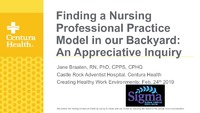| dc.contributor.author | Leclerc, Lucy | en |
| dc.contributor.author | Malone, Muun Queen E | en |
| dc.contributor.author | Mathis, Kendra Blassingame | en |
| dc.contributor.author | Abrams, Renecha | en |
| dc.contributor.author | Wilson, Tammy A. | en |
| dc.date.accessioned | 2016-07-13T11:09:01Z | |
| dc.date.available | 2016-07-13T11:09:01Z | |
| dc.date.issued | 2016-07-13 | |
| dc.identifier | INRC16G05 | |
| dc.identifier.uri | http://hdl.handle.net/10755/616286 | |
| dc.description | Theme: Leading Global Research: Advancing Practice, Advocacy, and Policy | en |
| dc.description.abstract | Session presented on Saturday, July 23, 2016: Purpose: Role clarification among Clinical Nurse Leaders (CNL) and Clinical Nurse Specialists (CNS) challenges the perceptive norms of all disciplines in an acute care setting. While the CNS role is steeped in history and familiar to frontline nurses, managers, physicians and ancillary disciplines, the CNL is a newer advanced practice role introduced in the past decade. Although it's easy to differentiate the two roles from a theoretical and conceptual perspective in which the CNL focuses on a microsystem and the CNS's scope pertains to a macrosystem, the true challenge lies in operationalization of the two roles within one organization. The purpose of this action research was to translate conceptual definitions and roles into an operational model of professional practice that clearly communicates the complex relationships of the CNL, CNS, Educator, their customers, their partners and their mission and vision as a professional practice team. Methods: Appreciative inquiry (AI) is an action research method that focuses on positive participatory inquiry within a system. AI assumes that organizational systems and groups function similar to human systems which are social systems. As such, an organizational system could be likened to an organism that is a living, breathing entity which functions at a higher level when change is introduced in a positive manner versus a problem-centered starting point. AI was carried out with our Professional Practice Team consisting of 9 CNLs, 3 CNS's and 8 Unit Based Educators in structured stages mirroring the five 'D's' of AI: 1) Define the Problem; 2) Discover; 3) Dream; 4) Design; and 5) Deliver. The Director of Professional Practice facilitated the AI process with the goal of nurturing identity clarification within the department as well as within the organization. The team met weekly with monthly retreats to allow full participation, voice and evolution of thought. Following full shared governance approval of the model by the Professional Practice team as well as the facility Practice Council, the model was rolled out to all customers, partners and invested stakeholders via town hall meetings, face-to-face education and informal in-services. Results: The primary result of this study was a Nursing Professional Practice model that illustrates the complex relationships of a professional practice team within an acute care organization. Secondary study outcomes include: 1) role clarification of the CNL, CNS and Unit-Based Educator within the organization; 2) operational realization of how the professional practice team affects micro, macro and mesosystems; 3) creation of role boundaries via role clarification and a formalized consult process for education and quality initiatives; and 4) pride and ownership Conclusion: AI proved to be a valuable venue for change and research into role clarification for the CNL and CNS within an acute care organization. Within the organization of interest, the CNL role had been in place for approximately one year without success in translating the role, as well as a lack of vision or mission for professional practice as a collaborative and consultative group serving a diverse customer base. AI proved to be a catalyst for transformational change within the organization. Following rollout of the Professional Practice Model to the organization, education, quality and safety initiatives evolved into a cooperative effort among all professional disciplines. The professional climate improved with a palpable strengthening of relationships between CNLs and their partners. | en |
| dc.format | Text-based Document | en |
| dc.language.iso | en | en |
| dc.subject | Clinical Nurse Leader | en |
| dc.subject | Clinical Nurse Specialist | en |
| dc.subject | Appreciative Inquiry | en |
| dc.title | Appreciative inquiry: Advancing practice of CNLs and CNSs by developing a visionary professional practice model | en |
| dc.title.alternative | Producing Innovations in Nursing Throughout the World | en |
| dc.rights.holder | <p>
All rights reserved by the author(s) and/or publisher(s) listed in this item record unless relinquished in whole or part by a rights notation or a Creative Commons License present in this item record.
</p><p>
All permission requests should be directed accordingly and not to the Sigma Repository.
</p><p>
All submitting authors or publishers have affirmed that when using material in their work where they do not own copyright, they have obtained permission of the copyright holder prior to submission and the rights holder has been acknowledged as necessary.
</p> | |
| dc.description.note | Items submitted to a conference/event were evaluated/peer-reviewed at the time of abstract submission to the event. No other peer-review was provided prior to submission to the Henderson Repository. | en |
| dc.type.category | Full-text | en |
| dc.contributor.department | Gamma Omicron at-Large | en |
| dc.author.details | Lucy Leclerc, RN-BC; Muun Queen E Malone, APRN ACCNS-AG; Kendra Blassingame Mathis, CNL; Renecha Abrams, RN, APRN, ACCNS-AG, CCRN; Tammy A. Wilson, RN | en |
| dc.conference.name | 27th international Nursing Research Congress | en |
| dc.conference.host | Sigma Theta Tau international, the Honor Society of Nursing | en |
| dc.conference.location | Cape Town, South Africa | en |
| dc.date.conferenceyear | 2016 | |
| dc.description.reviewtype | Abstract Review Only: Reviewed by Event Host | en |
| dc.description.acquisition | Proxy-submission | en |





